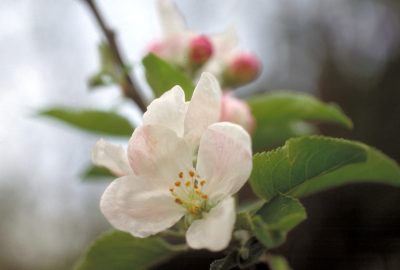
Apple pollination and thinning
 Apple
trees can take up to a decade to bloom and produce their first fruit,
so the rest of the book presents information I can only consider
theoretically. It sure is nice to dream about white apple
blossoms and growing fruits, though.
Apple
trees can take up to a decade to bloom and produce their first fruit,
so the rest of the book presents information I can only consider
theoretically. It sure is nice to dream about white apple
blossoms and growing fruits, though.
I was stunned to read
that an apple flower requires an average of 68 bee visits to ensure
proper pollination! It turns out that the multiple seeds inside
an apple need to be individually pollinated, and that a fruit with only
one or two seeds is likely to be dropped by the tree before it is
mature. Michael Phillips borrows honeybees to put in his orchard
at the critical period and sometimes even cuts his dandelion flowers
down to make sure the bees concentrate on apple blossoms. He also
encourages wild flowering plants at other times of the year to build up
his bumblebee
and orchard bee population.
Then, after carefully
getting as many of his flowers pollinated as possible (usually 1 in 8
will make fruit), he goes back to the orchard and manually thins the
tiny fruits to one apple per cluster. He also picks off fruits
until they are no closer together than four inches along the
branch. Thinning the apples about 35 days after full bloom helps
make sure his trees bear every year rather than lapsing into biennial
fruiting. He ends up with about the same weight of fruit as he
would without thinning, but the resulting apples are much larger.
| This post is part of our Growing Organic Apples lunchtime series.
Read all of the entries: |
Want more in-depth information? Browse through our books.
Or explore more posts by date or by subject.
About us: Anna Hess and Mark Hamilton spent over a decade living self-sufficiently in the mountains of Virginia before moving north to start over from scratch in the foothills of Ohio. They've experimented with permaculture, no-till gardening, trailersteading, home-based microbusinesses and much more, writing about their adventures in both blogs and books.
Want to be notified when new comments are posted on this page? Click on the RSS button after you add a comment to subscribe to the comment feed, or simply check the box beside "email replies to me" while writing your comment.
